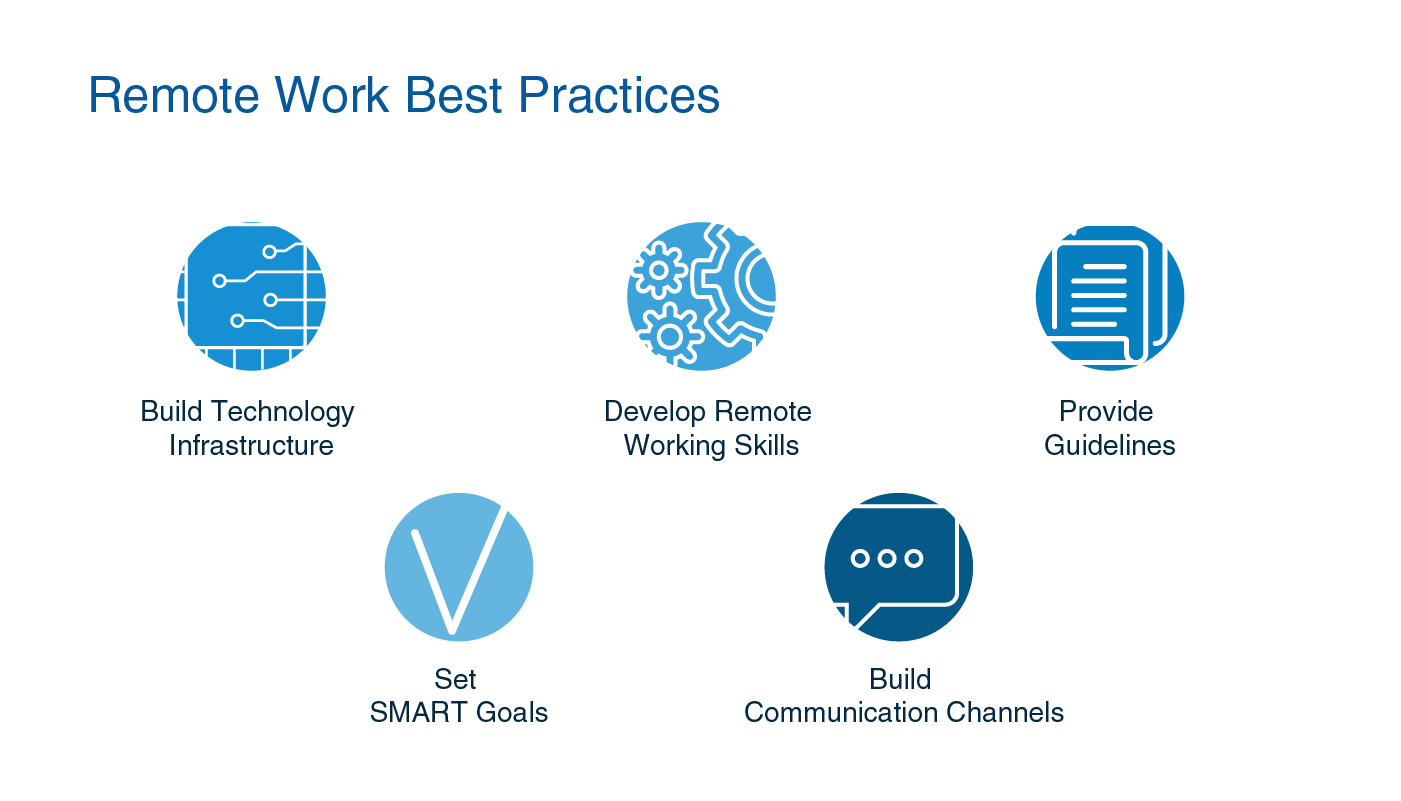As coronavirus pandemic spreads throughout the world, affecting more and more human lives, businesses across all domains have to prepare to adapt to the changing conditions. Numerous multi-billion corporations, such as Google, Apple, Facebook, Twitter and Microsoft, have already undertaken precaution measures to combat the growing health threat. Tech giants are actively encouraging their employees to use remote work opportunities if their job allows them to do so. While employees might see it as a chance to rest at home in sweatpants without the need to commute, entrepreneurs are prepared to face the biggest productivity challenge. Adjusting to remote work during the coronavirus crisis might be challenging if you lack proper skills and knowledge. In this piece, we are going to come up with a set of tips to manage your workforce remotely without compromising the quality and maintaining the same level of performance.
Why Do Many Companies Implement Remote Work Policies?
On March 11, the World Health Organization declared a coronavirus outbreak a pandemic. Public officials are deeply concerned about the severity and spread of a new virus, as well as the level of inaction and indifference in some regions. Thus, the organizations at all levels and in all industries are recommended to limit human-to-human interaction with an aim to stop transmission of the virus.
Even if your company is based in the low-risk region, you shouldn’t underestimate the threat of the disease. COVID-19 has already taken the lives of more than 4000 people, and there are 118 326 cases worldwide. According to the latest report provided by the World Health Organization, 113 countries in the world have been affected by a coronavirus outbreak with 4 new regions (Bolivia, Jamaica, Democratic Republic of the Congo and Burkina Faso) reported cases of COVID-19 during on March 11.

Such a rapid transmission poses a significant threat to businesses and their workforce. The cases of COVID-19 have been registered almost in all parts of the world, including Europe and the US. These regions are known as appealing destinations for business people and travelers, which makes it difficult to stop the spread of the disease in the world. Experts from WHO believe that the best way to prevent further escalation is to focus on teleworking until the situation improves. Companies even established a Staying Work club to encourage their counterparts to implement remote-work policies. By contributing to social distancing, you mitigate risks and maintain a healthy environment in the office.
Are We Actually Ready for Teleworking?
Working remotely is frequently seen as a great opportunity that provides workers with several extra hours in the morning, which they can use for their own purposes. A remote employee does not have to spend time on commuting, so they may focus on high-priority tasks. Furthermore, a well-thought-out remote strategy can help workers to establish a work-life balance.
However, are you actually ready for teleworking? In one of the studies, as of 2018, OECD has revealed that 6 out 10 individuals have never worked from home. In Italy, more than 60% of the population responded they do not have a relevant experience of working remotely. It means companies should be ready to educate their staff on the main skills required for teleworking and build processes in such a way that it won’t disrupt their operations.
Major Challenges of Working Remotely
- Communication in Virtual Teams.Working in the office with your team completely engaged in all the operations creates a sense of unity. Equipped with all the necessary techs and data, it is easier to get the work done quickly and efficiently. However, managing remote workers and communication in virtual teams differs much from office relations, and companies should prepare for this challenge in advance. You never know what the pain points you might face until you try to bring all your 200+ coworkers to a remote meeting. So, it’s better to prepare a plan beforehand to avoid communication breakdown.
- Keeping Track of the Operations. How would you make sure your employees are meeting KPIs? Do they follow all the processes? How do they communicate with clients? All these concerns need to be addressed to stay afloat and preserve your reputation on the market.
- Managing Productivity. While some of your employees are self-organized enough to plan their workflow, others will pay attention to working tasks only in the breaks between Netflix series. When your employees are away, it is more difficult to keep an eye on their performance. So, before you implement a work-from-home policy, think of the ways to track productivity in a company.
- Creativity Crisis. As Steve Jobs once said: “Creativity comes from spontaneous meetings. You run into someone, you ask what they are doing, you say ‘Wow’ and soon you’re cooking up all sorts of ideas”. Staying isolated for a long time might be harmful to people operating in creative industries. Even remote-work evangelists might experience a kind of crisis when they are stuck at home. So, if you run a creative agency or operate in a field that requires creative thinking, get prepared for this kind of challenge.
- Lack of Technology Infrastructure. Although businesses have all the tools for building effective virtual teams, the majority of them still feel unprepared to provide their staff with full-time remote employment. These difficulties stem from the lack of technology ecosystem that will enable both employees and employers to stay productive.

How to Manage a Remote Team?
In the conditions when businesses have faced the biggest remote-work experiment in the recorded history, the best pandemic strategy is to reduce human density in offices by allowing employees to work from home for a while. We prepared a set of best practices that will help you to manage remote teams without compromising the quality of your products or services:
- Build Technology Infrastructure. All the productivity challenges can be overcome with the help of specially designed software. Start with a simple task management system like Trello or Jira if you still do not have any. These tools will provide you with a helicopter view of all the processes, so you will always know what tasks your employees are working on and their status. Furthermore, you can get an advantage of time tracking software, such as Toggl or Timely, to ensure your teams are as productive in remote mode as they are in the office. Also, always have a contingency plan in mind. Whenever you feel the crunch is around the corner, contact a software development firm for support.
- Build Communication Channels. Communication often comes as a stumbling block for remote teams. When you experience difficulties at work or just lack information to resolve a particular task, you can easily reach out to your co-workers and ask them for help. But working remotely often means you’re left alone with your issues. To make sure your teammates can communicate regularly and effectively, use video conferencing software, such as Zoom, MeetingOwl, or Skype for Business. There are many alternatives out there, so you can test a few to make the right choice.
- Develop Remote Working Mindset. Productive remote teams are self-organized and disciplined. Educate your employees to stay online during their working day. A client or a manager should not wait hours until you workers get back to them as it may ruin your reputation of a reliable vendor or supplier. Moreover, your photos on accounts should be real to make you recognizable among the clients and managers.
- Provide Guidelines. In case you have to shift to remote mode quickly, at least provide your employees with clear guidelines on how they have to manage their workload, where they will track the time, and whom they can reach out in case of difficulties. Also, make sure this information is accessible so that everyone can read it.
- Set SMART Goals. If you don’t know where you’re heading, don’t be surprised when you come to the wrong place. Your employees should have clear goals and KPIs to be able to meet the requirements. Clear objectives might help your workers to stay on track and carry on working at the same pace.

Wrapping Up
Since nobody knows how long the coronavirus pandemic will last and whether there’ll be another crisis in the world, companies in all industries will be thrown in at the deep end. Managing remote teams is challenging, but this step will prepare businesses for the future and provide them with valuable lessons learned.
Want to build an innovative app to manage your employees remotely? Look at our IT outsourcing case studies and reach out to LITSLINK. Our seasoned software engineers will help you bring your ideas into life!




